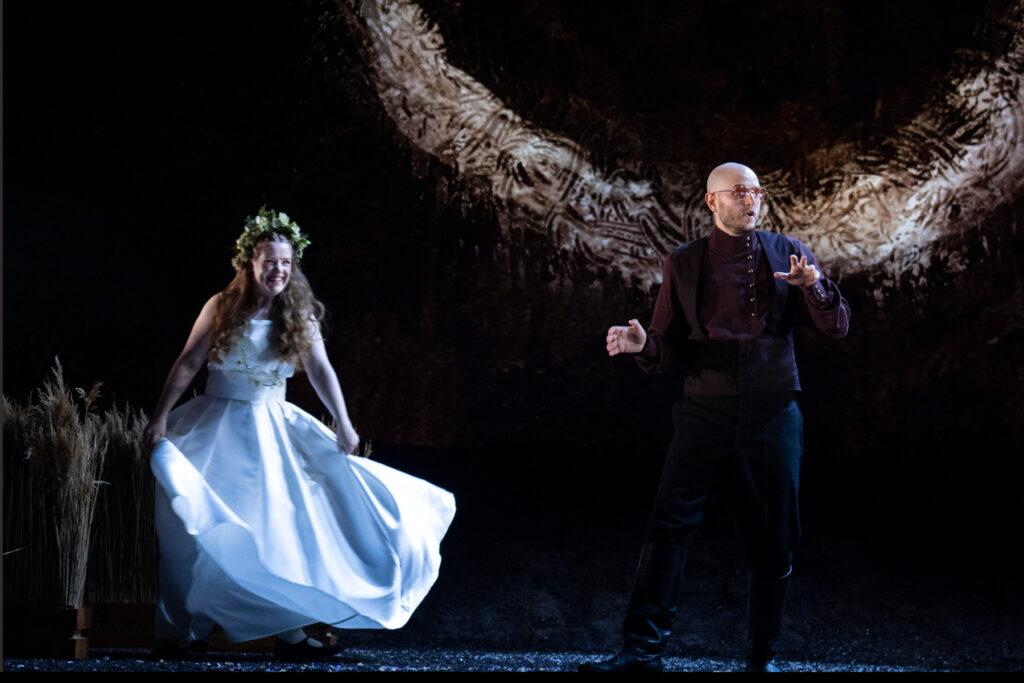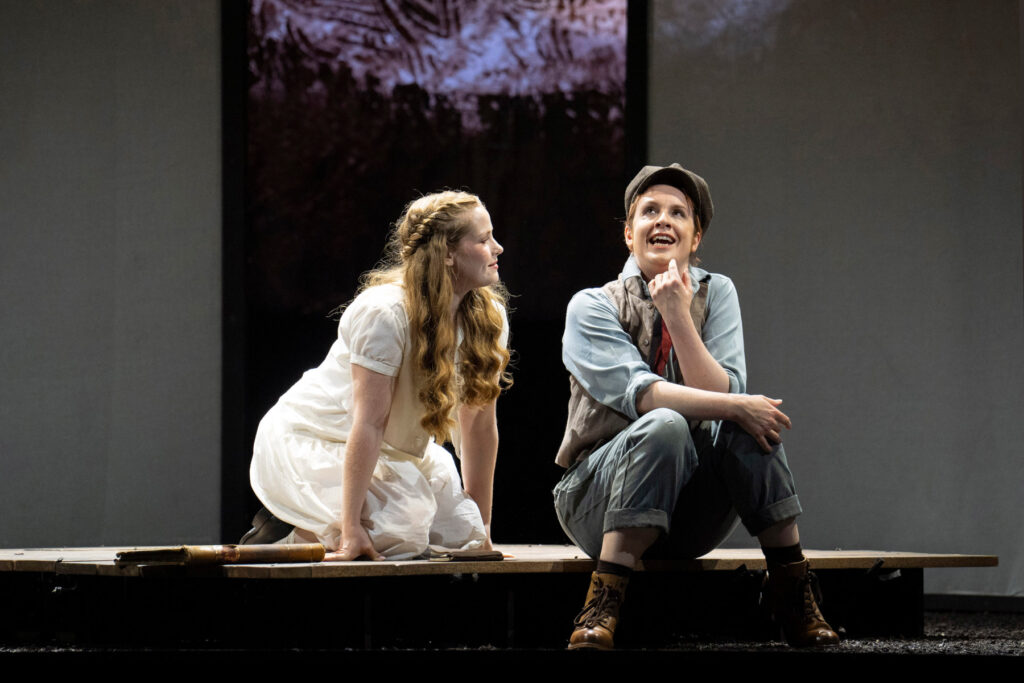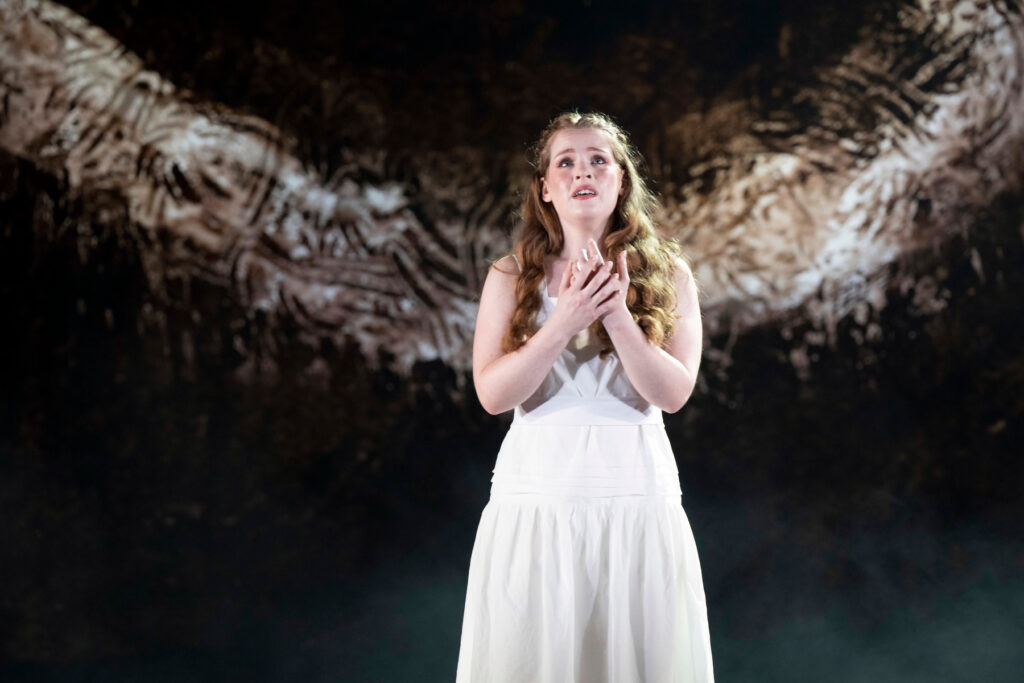Back in the dim and distant past there was climate change too. In the fairy tale that forms the narrative thread of Rimsky-Korsakov’s third and favourite opera, The Snow Maiden, the country has been in the grip of icy winters and chilly springs, causing havoc to harvests and harm to general well-being. This is deemed to be the fault – for in fairy tales somebody or something is always to blame – of an unlikely pairing between Grandfather Frost and Spring Beauty, whose daughter Snegurotchka, sixteen years on, stands at the brink of adulthood.
There are several interwoven narrative elements in the story, brought together by the figure of the snow princess herself. Domestic strife features strongly in the opening scenes, with an over-protective father and an indulgent mother at loggerheads over the fate of their daughter. Then there is the growing love between Lel, a shepherd boy and Snegurotchka; an ill-fated alliance between Kupava and her intended bridegroom, the rich merchant Mizgir; the Tsar, who as father of his people has to attend to the woes of the peasantry and provide emotional support; and the eternal problem of a young woman trying to establish her own identity in an alien world. Linked to that is the sacrifice of a female life: only with the death of Snegurotchka can the spell of never-ending winter be broken and the sudden onrush of spring, bringing with it renewed fertility, be triggered, a topic which has long fascinated Russian artists, most potently Stravinsky in Le Sacre du Printemps.

This opera has never really caught on with British audiences. There was a notable Opera North production in 2017 and sporadic interest has been shown by university and amateur operatic societies. Part of the problem may lie in Snegurotchka herself, who is detached for most of the action, unfeeling and uncomprehending as a supernatural being in the human world, tossed across the currents that dominate the lives of mortals. Unlike the death of Mimi in La Bohème, for instance, there is no sense of overwhelming grief at the passing of the heroine. The music, however, is another matter. Rimsky-Korsakov’s teeming melodic invention and vibrant orchestral colour delight the ear, with The Dance of the Tumblers (here used as a prelude to Act 3) a particular highlight of the score.
This production by English Touring Opera had a general level of excellence, with a few reservations on my part. The stage was dominated throughout by a symbolic ring set against the backcloth. Subtle changes in lighting gave it the appearance of an ornament covered in hoar-frost, a harvest wreath and a corona of the sun. Snegurotchka’s continuing attachment to childhood was symbolised by her immersion in a picture book and her embracing of a rocking-horse (one of the few props). Olivia Fuchs as director marshalled her limited resources intelligently: nothing was ever too static or over-busy, and the balletic episodes depicting an earlier carnival together with the riotous rejoicing at the arrival of spring towards the close created visual highlights. Costumes were mostly appropriate and pleasing to the eye. There were the usual anachronisms and aberrations: hairstyles for both men and women clearly grounded in the 21st century; modern waist belts; Grandfather Frost sporting a bowler, a brolly, an attaché case and one of British tailoring’s finest exhibits (complete with watch-chain); Lel using a ballpoint pen to note things down; the application of make-up including lipstick to Snegurotchka as she progresses to womanhood; ridiculous pink-lensed eye-shades as protection against the sun; and a Tsar looking like a pantomime refugee, kitted out in a low-cut, embroidered green ballgown.

The role of Snegurotchka is challenging in so many ways. It requires a fresh-toned, youthful voice with the agility to encompass leaps in what is already a high-lying tessitura, and a touch of bel canto richness for the coloratura elements, chiefly in her opening aria in the Prologue but equally in her final Act 4 aria. As the snow princess, Ffion Edwards looked the part and often sang angelically. Her demeanour was also well considered: demure and subdued at the outset yet appreciative of the character development within the opera. By the time she sings “All of me is ecstasy” in the concluding act, her eyes have been opened to beauty and feelings of true love.
Her counterpart is the feisty Kupava, the girl who seemingly has it all. Though dumped by Mizgir, she is later smitten with Lel. Katherine McIndoe has a voice of almost Wagnerian proportions, commanding, forceful and therefore dominant in the wrong kind of way, yet still encompassing the vulnerability and distress of a rejected woman. Kitty Whately in the trouser role of Lel was suitably gamine. She has three important songs during the course of the opera: these account for her instant appeal to Snegurotchka and the other village girls, delivered here with much lyrical intensity.

I found Edmund Danon’s warm baritonal presentation of Mizgir alluring, yet he also had the right vicious snarl in the voice for his cruel treatment of Kupava. Less persuasive was Joseph Doody’s Tsar Berendey, the occasional whining tone bordering on a falsetto, and without the gravitas expected of a ruler. There were no weak links in any of the other casting; the small vocal ensemble acquitted themselves favourably, though the parlando elements in earlier recitatives often lacked focus.
Hannah Quinn in the pit held things together very capably, always giving precise cues. On the debit side, her over-cautious metronomic beat did bring an occasional stiffness to the musical flow, and I found the dynamics a little unyielding. Even with a very modest eighteen-piece orchestra true softness was in short supply, though in the big ensembles and passages where Rimsky-Korsakov pulls out all the stops there was no shortage of ebullience. Listening to this small band of players, I was frequently reminded of the composer’s glorious Quintet in B flat major for woodwind and piano, with its cornucopia of magical sounds. In its florid writing the Chorus of the Birds in the Prologue gave the ETO woodwind a chance to shine.
At its close the opera offers the audience a reflective summary of its three key ingredients: Life, Light, Love. That is quite a happy mix for any opera, despite the sadness it leaves at the end.
Alexander Hall
The Snow Maiden: A Spring Fairy Tale (Snegurochka)
Music by Nikolai Rimsky-Korsakov, in an orchestration by Patrick Bailey
Opera in a prologue and four acts with a libretto by the composer based on a play by Alexander Ostrovsky
English Touring Opera Production
Sung in English with English surtitles
Cast and Production Staff:
The Snow Maiden – Ffion Edwards; Lel – Kitty Whately; Kupava – Katherine McIndoe; Mizgir – Edmund Danon; Spring Beauty – Hannah Sandison; Grandfather Frost/Bermyata – Edward Hawkins; Tsar Berendey – Joseph Doody; Bobyl – Jack Dolan; Bobylikha – Amy J Payne; Spirit of the Wood – David Horton; Maslenitsa – Neil Balfour; Alexandra Meier – Tsar’s Page; Ensemble Members: Phoebe Smith; Natasha Agarwal; Judy Louie Brown; Harry Grigg; Phil Wilcox
Olivia Fuchs – director; Eleanor Bull – set & costume designer; James Platt – lighting designer; Alisdair Middleton – librettist; Monica Nicolaides – assistant & movement director; Molly Harris Farley – assistant director; Orchestra of English Touring Opera; Hannah Quinn – conductor
Hackney Empire, London, 28 September 2024
Top image: Cast of ETO’s The Snowmaiden.
All photos © Richard Hubert Smith.
Further tour dates until 16 November